Care Guide for Slipcovers: How To Wash and Store
March 2, 2023
Slipcovers are a great way to protect your furniture from spills, stains, and everyday wear and tear. However, just like any other garment, slipcovers require proper care to maintain their look and feel. If you're wondering how to wash and store your slipcovers to keep them in pristine condition, this care guide is for you. From selecting the right washing method to properly storing them, we'll cover all the important steps to help you keep your slipcovers looking fresh and clean for years to come. So, let's dive in and learn how to take care of your slipcovers like a pro.
WASH FREQUENCY
As needed
STORAGE METHOD
Fold
The Right Way To Wash Slipcovers
Slipcovers are a great way to protect your furniture, but they can get dirty over time. The best way to clean slipcovers depends on the fabric type, so always check the care label for specific instructions. Here are some general guidelines to help you wash slipcovers:
Machine Washing Slipcovers
- Check the care label to see if the slipcover is machine washable. Some slipcovers may require dry cleaning only.
- Remove any cushions or attachments from the slipcover.
- Place the slipcover in the washing machine and add a small amount of mild detergent according to the package instructions.
- Use a gentle cycle and cold water to prevent shrinkage or damage to the fabric.
- If the slipcover is made of a delicate fabric, put it inside a mesh laundry bag to prevent damage.
- After the wash cycle is complete, remove the slipcover from the washing machine and hang it up to air dry. Do not put the slipcover in the dryer as it may shrink or damage the fabric.
If the care label indicates that the slipcover should be hand washed, follow these steps:
- Fill a large basin or bathtub with cool or lukewarm water and add a small amount of mild detergent.
- Remove any cushions or attachments from the slipcover.
- Place the slipcover in the water and gently scrub it with your hands, paying extra attention to any stains or soiled areas.
- Rinse the slipcover thoroughly under running water to remove all the soap.
- Gently squeeze out the excess water. Do not twist or wring the slipcover as it may damage the fabric.
- Hang the slipcover up to air dry. Do not put it in the dryer as it may shrink or damage the fabric.
If the care label on your slipcover says "Dry Clean Only," take it to a professional dry cleaner. Do not attempt to wash it at home as it may damage the fabric or color. Dry cleaning is a special process that uses solvents to clean delicate fabrics without water. Professional dry cleaners have the knowledge and equipment to handle different types of fabrics and embellishments, and can help ensure your slipcover is cleaned safely and effectively.
How Often To Wash Slipcovers
Slipcovers should be washed as needed, but not too frequently. Excessive washing can damage the fabric and make them less durable.

The Right Way To Store Slipcovers
How to Fold Slipcovers
- Lay the slipcover on a flat surface, front side down.
- Fold the slipcover in half vertically, matching the armrests to the opposite sides.
- Fold the slipcover in half again horizontally, tucking the skirt inside.
- Smooth out any wrinkles or creases.
Expert Advice for Maintaining The Quality Of Your Slipcovers
To keep slipcovers in top shape, it's important to follow some practical tips. Firstly, avoid washing them with heavy or abrasive materials like towels or denim. It's also important to secure any closures, such as zippers or velcro straps, to prevent snagging or damage to the fabric. Washing slipcovers inside out can help protect the surface of the fabric and prevent fading. Using salt as a mordant or dye-fixer can also help prevent color bleeding for new slipcovers. Investing in mesh bags or a proper drying rack can help reduce wear and tear during the washing and drying process, especially for delicate fabrics. It's recommended to skip the dryer whenever possible and air dry slipcovers to prevent shrinkage or damage to the fabric. Lastly, following the care label instructions is crucial to keeping slipcovers in top shape, so always refer to the manufacturer's recommendations for best results.
DISCLAIMER
Just a friendly reminder that this care guide for slipcovers only provides general advice. Your slipcovers may have specific care requirements based on its material, style, and manufacturer instructions, so always check the care label before washing or storing it. If you're unsure about anything, it's always best to consult a professional cleaner. Please note that the author of this guide is not responsible for any damages or losses resulting from the use or misuse of any information from this blog.
Want to share this?
